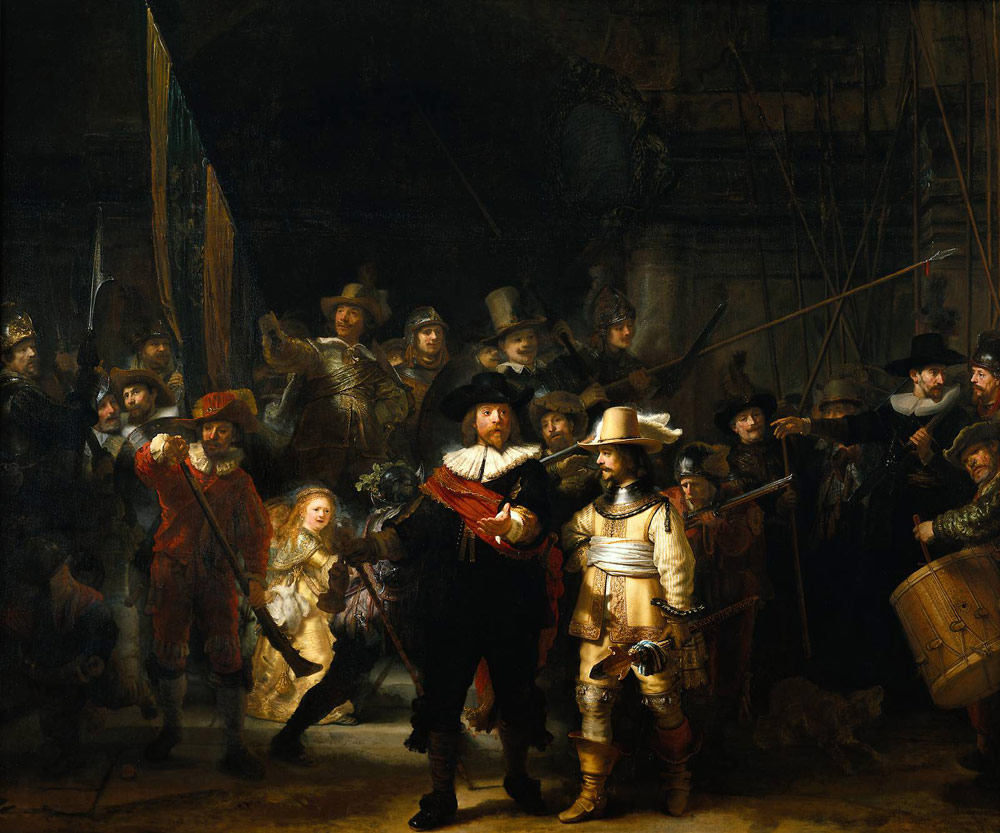| The Night Watch | |
|---|---|
 |
|
| Artist | Rembrandt |
| Year | 1642 |
| Medium | Oil on canvas |
| Location | Rijksmuseum, Amsterdam |
| Dimensions | 142.9 in × 172.0 in |
| 363 cm × 437 cm | |
| Rembrandt Famous Paintings | |
| The Night Watch | |
| The Return of the Prodigal Son | |
| Self-Portrait | |
| The Jewish Bride | |
| Danaë | |
| The Mill | |
| The Storm on the Sea of Galilee | |
| The Blinding of Samson | |
| The Three Trees |
Rembrandt painted The Night Watch in 1642 and is known as one of his most famous paintings. It is also been recognized as one of Rembrandt’s most debatable and controversial works of art. The Night Watch is the largest painting (at 142.9 in x 172.0 in) in Rembrandt’s line of work. The light and dark contrast in the military portrait is very well recognized.
The captain of the civic militia guards and 17 of its members are thought to have commissioned the painting and paid Rembrandt 1,600 guilders to paint The Night Watch. This was considered a great deal of money in that era. There are thirty-four figures that appear in The Night Watch.
The painting is an oil painting on a canvas that depicts militiamen lead by Willem van Ruytenburch and Frans Banning Cocq, located in the front area of the painting. At the time of the painting of The Night Watch, it was very common for militia units to commission painters for their portraits. At this time in history the 30 Years’ War from 1618-1648 was halfway through, and it was a time when the Netherlands sought independence from Spain.
In the painting, the mayor of Amsterdam and Captain Franz Banning Cocq are seen standing next to the lieutenant Willem van Ruytenburch. The light of the painting shines mostly on Cocq and Ruytenburch with them being the main focal point and the rest of the men surrounding them. Also in the light, a little girl clothed in yellow is seen behind Cocq. The eye is naturally led to these three main characters shining out of the crowd. This is because of the sunlight and shadow features that Rembrandt uses in the most effective ways in the painting. Behind these three characters is the ensign whose name is Jan Vissher Cornelissen. He carries the company’s colors with him in the painting.
There were changes made to the first painting such as cutting it to fit into the town hall in Amsterdam in 1715. All four sides of the painting were cut before moving it to the town hall and later the painting was again moved to Trippenhuis or what was later called Rijksmuseum. In 1939 when World War II began, it was moved to Medemblik, and rolled into a cylinder form. The painting was brought back to Rijksmuseum when the war ended. Considering the very large size of the painting, and how many times it was moved, it remained in astonishing condition.
The Night Watch is also known to have recovered from at least two vandalism attacks. One of the attacks occurred in 1975 when someone left zigzag marks by using a butter knife on the painting. Another horrible incident occurred in 1990 by a man spraying acid on this great work of art. The painting still shows some of the zigzag marks even though the painting has been fully restored. The Night Watch painting is today displayed in the Rijksmuseum, Amsterdam in the Netherlands and is considered to be the most famous painting displayed there.